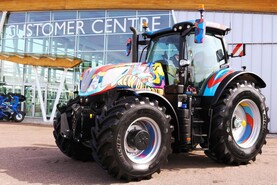Losses have been high for farmers in the northeast of England due to the poor weather this year, according to Richard Findlay.
“This year has been relentlessly wet,” he said.
“The losses are still high. We can stand the cold, we can stand the wet but when the two come together it’s a problem. The fallen stock companies are currently putting in three times as many stock into the incinerator.”
Findlay is the National Farmers Union of England livestock chair and farms a mixed holding in Westerdale in the North York Moors National Park. His farm is about 20 miles inland from the east coast. It received quite a bit of cold weather but usually dry.
So far his ewes are in three weeks longer than usual. He turned out just 120 of his 900 ewes last week.
“We are fortunate we have plenty of sheds, our main expense has been concentrate feed. We’re spending £1,000/week more on feed than usual. But we haven’t had the same level of losses seen on neighbouring farms, where 10% to 15% of lambs have been lost.”
Despite sheep outside receiving additional feed, they are not milking as well, which is causing most of the problems. While Findlay would expect to lose one lamb in every 100, this year he expects it is closer to 5%. The demand from Ireland for fodder is having an impact.
“The Irish Government’s fodder transport scheme is having an impact. It ramps up the price. We’ve got people paying £60/bale for straw,” he said.
Supplies of fodder across the UK have tightened. In the northwest of the country, sheep farmer Hannah Jackson has been tweeting about lambs being stuck in mud after high levels of rainfall.
Extreme lamb revival!
— Hannah Jackson (@redshepherdess) April 10, 2018
Found these poor lambs stuck in mud due to excess rain last night.
Hair dryer to dry them off as much as possible. Tubed with a small amount of warm milk. Now they’re in the heat box.
Finger crossed ???? pic.twitter.com/hhtahqczR1
€60m/week cost to fodder crisis






 This is a subscriber-only article
This is a subscriber-only article









SHARING OPTIONS: